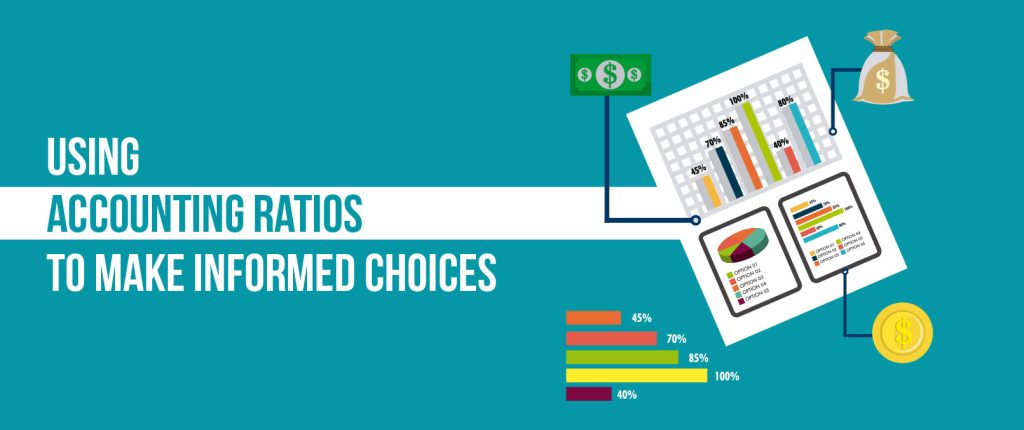Leveraging Financial Statements for Making Informed Business Decisions
Poor uninformed decisions cost billions to companies.
Decisions are made everyday in companies. And poor decisions don’t just cost money. They cost a company’s time, personnel and great ideas. Today, companies that thrive are the ones that leverage their financial information to make informed decisions.
Investopedia highlights how financial accounting helps in decision making. There are several ways for companies to make better business decisions. This article discusses:
- how using accounting ratios can help managers and business leaders “read” the financial statements and
- how horizontal analysis of the financial statements can help companies make informed decisions.
So, stay tuned.
Using Accounting Ratios To Make Informed Choices

There are four financial statements:
- Statement of financial position
- Income statement
- Cash flow statement
- Statement of changes in equity
Using financial statements to make informed decisions means that you learn how to read the financial reports. This enables you to answer questions like:
- Is there anything going wrong in the company?
Have your expenses increased? Or is your inventory staying too long in the warehouse? Do you have enough cash on hand to pay your short-term debts? Do you have enough cash to pay your interest payments on time?
- What do I need to change?
Should you increase your prices to compensate for the increase in expenses? Or can you control the costs? Can you renegotiate prices with your supplier?
- What do we need to focus on?
Should you focus on building your brand and improving quality?
- What do we need to improve?
Accounting ratios are used to compare one item on the financial statement with another. Most of the accounting ratios can be derived from the income statement and the statement of financial position (balance sheet).
Accounting ratios are divided into five main groups.
1. Profitability ratios
One of the profitability ratios is margin ratio. Margin ratios tell us how well a business converts revenue into profit. This means how much profit the company generated from each dollar of revenue earned.
Margin ratio= Profit/Revenue
A low margin ratio indicates that the company is not earning enough revenue to cover its expenses.
A company that has accurate financial records will be able to take prompt action in response to a low margin ratio. In such a case, the company can increase the price of its products/services or take measures to reduce its expenses.
2. Liquidity ratios
Liquidity ratio= current assets/current liabilities
Cash ratio=cash/current liabilities
Cash ratios are a good indicator of the business’s financial health. Liquidity ratios help companies decide whether the business can cover its short term debt obligations using its liquid assets.
Usually a liquidity ratio of less than 1 indicates that a company might have problems in the near future paying its short term debts (like payments to its suppliers, for example). Of course it is best to look at the overall picture before making a final decision about the company’s liquidity.
3. Efficiency ratios
Efficiency ratios measure how effective a business is at selling inventory to customers. There are two efficiency ratios:
Inventory ratio tells us how many times a business has sold and replenished its inventory over a period of time. Its formula is the cost of goods sold/inventory.
The receivables turnover ratio and payables turnover ratio works in a similar way to inventory ratio. Asset turnover ratio tells how efficiently a business generates its revenue by the amount of assets it owns.
Cash conversion cycle tells us the average number of days a business needs to convert its investments in inventory into cash. This means how long it takes for the business to turn over inventory, collect cash on sales, and pay bills.
Leverage ratios
Leverage ratios are financial metrics that provide insights into a company’s capital structure and its ability to meet its financial obligations. They can be divided into two categories: balance sheet ratios and income statements ratios.
These ratios can assess a company’s risk profile, financial health, and efficiency in utilizing debt and equity.
One of the most common leverage ratios is the debt-to-equity ratio.
Debt-to-Equity Ratio (D/E) measures the proportion of a company’s financing that comes from debt relative to equity. A high D/E ratio indicates a higher level of financial risk and may imply that the company relies heavily on debt for its operations. Investors and creditors may be concerned about the company’s ability to repay debt. Management may consider reducing debt or increasing equity to improve financial stability. The formula of debt to equity ratio is Total Debt / Total Equity.
Interest Coverage Ratio
When a company acquires debt it has to be regular interest payments. Interest coverage ratio measures a company’s ability to cover its interest expenses with its operating earnings. The formula for interest coverage ratio is Earnings Before Interest and Taxes (EBIT) / Interest Expenses. A low interest coverage ratio indicates that the company may struggle to meet its interest obligations. This could raise concerns for creditors and may lead management to reduce debt or improve profitability.
Price ratios
One of the very important ratios are the price ratios. Investors use these ratios for financial analysis of the share price of the business and determine whether it is a worthwhile investment. These ratios provide insights into a:
- company’s valuation,
- financial performance, and
- market sentiment.
Horizontal Analysis of Financial Statements
Financial analysis involves analyzing the financial performance and position of an organization. One of the tools for companies to gain insights into their financial performance and make informed decisions is horizontal analysis.
It involves examining historical trends and patterns on the financial statements over multiple periods. Horizontal analysis helps businesses to better understand their financial health, identify areas for improvement, and develop strategies to achieve their financial goals.
Here are ways how horizontal analysis can help companies make informed decisions:
– Identify Trends and Patterns
By comparing data from multiple periods, managers can see if revenues, expenses, or other financial metrics are consistently increasing, decreasing, or remaining stable.
-Assess Financial Performance
Horizontal analysis helps in evaluating whether the company is growing, stagnating, or experiencing financial distress.
-Detect Anomalies or Irregularities
By comparing financial data across periods, companies can spot irregularities or anomalies that may require further investigation. Sudden spikes or declines in expenses or revenues could indicate operational issues or accounting errors.
-Budgeting and Forecasting
Historical data from horizontal analysis can be used as a basis for budgeting and forecasting. By understanding past trends, companies can make more accurate projections for future financial performance.
-Decision-Making on Investments and Expansion
Companies planning to invest in new projects, acquisitions, or expansions can use horizontal analysis to gauge their financial capacity and assess the impact on their financial statements. It helps in determining whether the company has the resources and stability to undertake such initiatives.
-Performance Evaluation
Management can use horizontal analysis to identify areas that are performing well and those that need improvement.
-Benchmarking
Companies can compare their financial performance with industry peers or competitors using horizontal analysis. This benchmarking helps in understanding how the company stacks up against its rivals and identifies areas where it may need to improve.
-Debt Management
For companies with debt obligations, horizontal analysis can help in monitoring the ability to service debt over time. It provides insights into whether the company’s debt burden is increasing or decreasing relative to its financial performance.
When companies are not getting the results they want. It is time to change their activities. Look for alternative solutions to your problems. One of the solutions to control payroll cost is to outsource some of the non-operating activities of your business, for example.
Leverage the Power of Precise Financial Reporting
In the world of business, accuracy is everything. Inaccurate financial reporting isn’t just a simple mistake; it’s a ticking time bomb of consequences waiting to explode!
It can sabotage your decision-making, ruin your reputation, drain your finances, and even lead you down the treacherous path to penalties, fines, legal battles, and the dreaded “B” word: bankruptcy.
That’s why, now more than ever, you need to ensure that every single digit, every line item, and every financial statement is not just accurate but also up-to-date. Your company’s financial health depends on it, and we’re here to make sure you stay on the right side of financial success.
Say goodbye to uncertainty and hello to financial peace of mind with Work Accelerated. We provide premier outsourcing & staff augmentation services in accounting & bookkeeping.
At WA, we’re not just offering services; we’re delivering tangible benefits that can transform your business. With our precise financial reporting, you’ll make informed decisions based on real data, leading to better strategies, improved resource allocation, and increased profitability.
Our cost-effective services can save you money in the long run. Avoid costly errors, penalties, and fines by entrusting your financial management to our experts.
Join the ranks of satisfied businesses that have experienced these remarkable benefits firsthand. Contact us today to learn more about how we can elevate your financial management and drive your company toward greater success.

